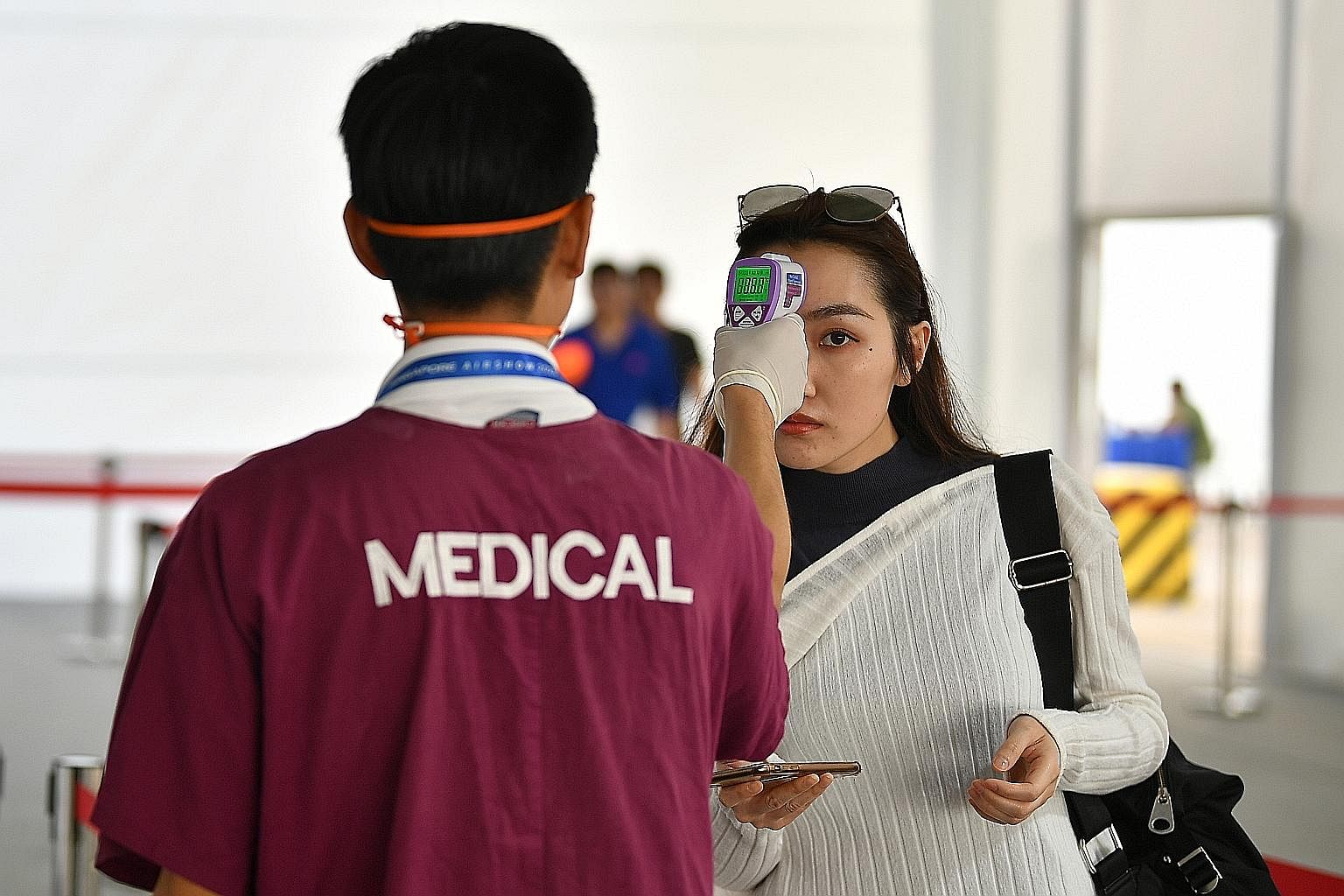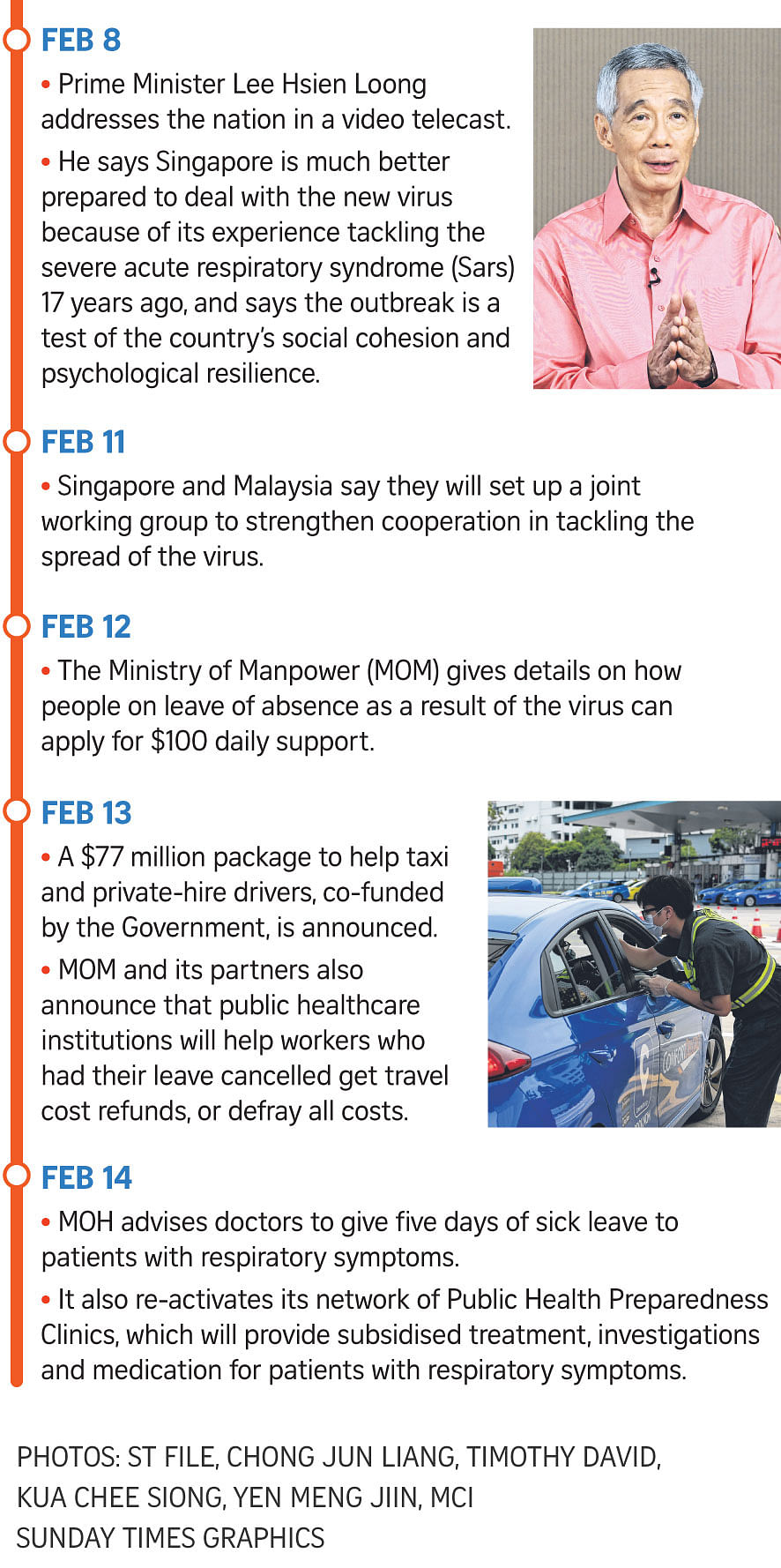Coronavirus: Front-line Fighters
5 turning points in Singapore’s fight against the coronavirus
It has been seven weeks since the world learnt of a new coronavirus that emerged in the Chinese city of Wuhan. It has killed more than 1,500 people so far in China. In that time, the Singapore Government has rolled out a steady stream of measures to curb its spread here.
Sign up now: Get ST's newsletters delivered to your inbox

Temperature screening for visitors to the Singapore Airshow 2020 yesterday at Changi Exhibition Centre.
ST PHOTO: LIM YAOHUI
Follow topic:
At the Criminal Investigation Department's Command Centre in Outram last Thursday afternoon, 20 police officers were hunched in front of their computers, trying to make sense of how the coronavirus is spreading in Singapore.
Working with the Ministry of Health (MOH) - which is in charge of contact tracing - as well as detectives on the ground, they are helping to piece together the movements of those infected.
People who had been in close contact with a patient will be traced. If they are well, they will be put under quarantine for 14 days. If they show symptoms, they will be treated as a suspected case, hospitalised and looked after.
The officers are part of the government machinery that has kicked in to manage the outbreak.
Their mission: treat patients, contain the spread, allay the fears of Singaporeans and help businesses that have been hit.
Outside the public sector, thousands have also been mobilised to the front lines.
They include private general practitioners who are often the first medical contact a patient has, security firms helping to serve quarantine orders, cleaners who disinfect places that patients had been to, and even religious leaders who have control over mass gatherings.
REALITY STRIKES
The coronavirus emerged in Wuhan late last year. On Dec 31, the Chinese health authorities reported it to the World Health Organisation (WHO), which then told the world.
WHO has since named the virus Sars-CoV-2. The disease it brings - characterised by fever and cough and in severe cases, pneumonia that can be fatal - is now called Covid-19.
As of Friday, China has more than 66,400 reported cases with 1,523 reported deaths, mostly in the province of Hubei where Wuhan is.
Globally, there are more than 67,000 reported cases and, outside of China, four reported deaths. As of yesterday, Singapore has 72 confirmed cases.
It has been three weeks of heightened caution and nervousness for the Republic since the first case here was discovered on Jan 23, the Thursday before the long Chinese New Year weekend.
In that time, Singaporeans have gone from being concerned to alarmed, to now accepting, with a growing sense of realisation that the virus will be around for some months yet.
There were irrational moments, like last Saturday when shoppers were seized by fear that Singapore would run out of toilet paper and other essentials, and emptied supermarket shelves.
Officers from Reach, the Government's feedback gathering unit, have been talking to Singaporeans about the virus from around the Chinese New Year period.
The team of about 25 officers do face-to-face interviews in places ranging from the heartland to universities. They also conduct online polls and gather people to chat via WhatsApp.
Officers say there is very high interest in the virus, with people eager to find out more.
Mr Marcius Sim, 27, an assistant manager at Reach, said: "People aren't always willing to talk to us, but now with the virus, they are happy to give feedback."
There are three concerns the Reach officers keep hearing: fear of contracting the virus, worry that more people will get it, and its impact on the economy and businesses.
Ms Hillary Lau, 28, also an assistant manager at Reach, said a common sentiment she hears in the 200 or so face-to-face interviews she has done, is this: "I just want this to be over soon."
KEY MOMENTS
There have been five key dates in Singapore's fight against the virus so far:
• Jan 23 when the first case - a 66-year-old man from Wuhan - was detected here.
• Jan 28 when a travel ban was imposed on visitors with recent travel history to Hubei, or those with Chinese passports issued there.
• Feb 1 when travel restrictions were expanded to include those with recent travel history to China, or those who have Chinese passports.
• Feb 4 when the first locally transmitted cases were announced.
• Feb 7 when the Government raised its risk assessment of the outbreak from yellow to orange.
The first case here emerged a day after the setting up of the multi-ministerial task force to contain the virus.
Helmed by Health Minister Gan Kim Yong and National Development Minister Lawrence Wong, the group is advised by Deputy Prime Minister Heng Swee Keat, who is also Finance Minister.
The task force has held several press conferences together with medical experts from MOH. Starting last week, these briefings became more frequent.
Up until the Chinese New Year weekend from Jan 25, Singaporeans were concerned about the virus but not overly so.
The early cases were confined to tourists from China whose movements were largely around touristy areas.
On Jan 27, however, it was reported that one of the visitors from Wuhan had stayed with her family in the residential Ceylon Road.
The next day came news that a male patient from Wuhan had stayed in a condominium in Pasir Ris. The virus, it appeared, had moved to the heartland.
In the days that followed, stories of suspected cases at malls with GP clinics started being shared.
At pharmacies, the demand for face masks began to escalate. As people shared images of queues, it had a knock-on effect and more started queuing, despite reassurances by the Government that it had released five million masks to retailers.
At online mall Qoo10, a listing advertised 30 "anti-coronavirus" masks for sale at $10,000. It was removed on Jan 29.
The Government knew something had to be done to stem the feverish demand for masks.
On Jan 30, it announced that all 1.37 million households will be given four surgical masks each from Feb 1. It also drummed into Singaporeans the message that only those who were sick should wear a mask.
The Singapore Armed Forces was activated to pack the masks and logistics were put in place to distribute them at residents' committee centres and community centres.
The move calmed the panic. When the actual distribution of masks started on Feb 1, there were no queues.
FIGHTING XENOPHOBIA
By the weekend of Feb 1, it was also becoming clear that fear of the virus was turning into discrimination against Chinese nationals.
Stories started emerging of how Singaporean landlords were telling their Chinese tenants returning from the new year to stay away.
The Government nipped this in the bud.
On Feb 3, the Manpower, Education and National Development ministries said landlords found to have irresponsibly evicted their residents may face restrictions and even be barred from renting out their flats to foreign work pass holders in future.
On the business front, it was also clear that the travel restrictions to stem the spread of the virus were hurting businesses, especially those in the tourism industry.
On Feb 1, DPM Heng said the Government would provide targeted support to sectors directly affected by the virus.
The next day, Minister for Trade and Industry Chan Chun Sing said the Singapore Tourism Board will be implementing targeted measures such as waiving the licence fees for hotels.
As these measures were being rolled out, the Government was also preparing the ground for the possibility of local community spread.
On Feb 3, Mr Gan spoke of this. The next day, it was announced that Singapore had seen its first local transmission of the virus.
Four people connected to the Yong Thai Hang health products shop in Cavan Road were infected without having travelled to China. Their infection, though, could be traced to a Chinese tour group that had visited the shop. The authorities termed this a "local limited transmission".
Following this case, the task force decided that schools would implement staggered recess times and stop certain activities.
On the ground, people started becoming more fearful of picking up the virus. Cleaning products were snapped up at shops.



CODE ORANGE
On Feb 7, rumours went around that the Government would be raising its risk assessment from yellow to orange. True enough, this was announced at a press conference in the afternoon.
Under the orange alert, temperature taking is instituted at buildings. The Ministry of Education also suspended all inter-school and external activities till the end of the March school holidays.
The alert, however, led to a round of frenzied shopping at supermarkets from Feb 7 through to the next day. Some calm was restored on the evening of Feb 8 when Prime Minister Lee Hsien Loong addressed the nation in a video telecast.
He spoke of how Singapore was much better prepared to deal with the new virus because of its experience in tackling the severe acute respiratory syndrome (Sars) outbreak 17 years ago. Fear and panic, he said, would do more harm than the virus.
The team from Reach said its surveys showed that 80 per cent of those who heard PM Lee's message felt more reassured by it.
In the last few days, another large cluster has emerged around the Grace Assembly of God church. Across the island today, mass and some services have been cancelled as a precautionary e measure.
It is clear the current orange alert may be around for some months yet.
On Friday, PM Lee noted that what Singapore is seeing is a "very intense outbreak" and the impact of the coronavirus was much more than Sars. It took five months to eradicate Sars.
"That was, I think, very fast. I expect it not to be so fast this time," he said of the new threat.
Like the rest of the world, Singapore will have to learn to deal with the coronavirus till it, hopefully, goes away.

